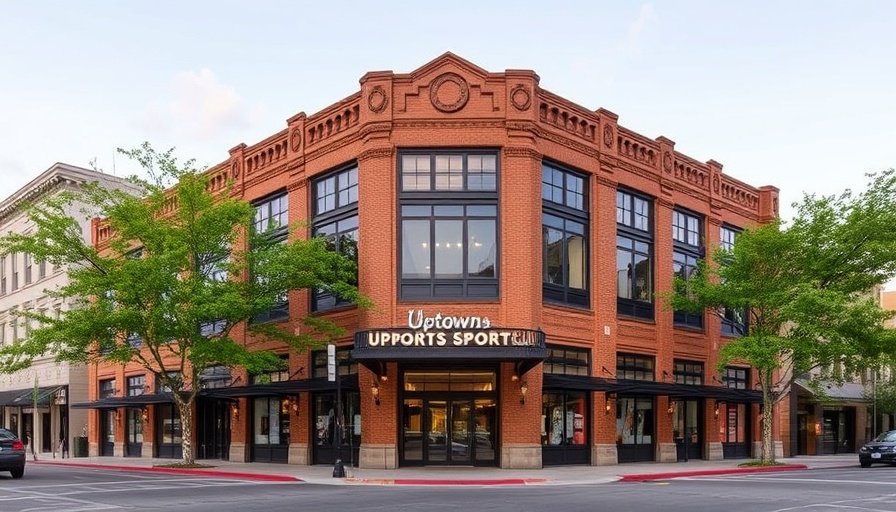
Transforming 1890s Austin: A New Era for Historic Spaces
In recent years, the trend of adaptive reuse has been reshaping urban landscapes, where historical buildings are lovingly transformed into new spaces that serve modern needs while respecting their past. A prime example of this is the Uptown Sports Club in Austin, Texas, artfully renovated by Michael Hsu Office of Architecture. This vibrant venue breathes new life into a 130-year-old structure, seamlessly blending elements of history with contemporary design.
Breathing New Life into Heritage
The Uptown Sports Club, originally built in 1893 as a bakery and butcher shop, now operates as an all-day eatery and gathering spot that reflects both its historical roots and modern sensibilities. Michael Hsu, the founder of the architecture firm responsible for the transformation, emphasizes that this project honors the building’s legacy while integrating a friendly and inviting atmosphere that appeals to and engages the community. “This project celebrates a great building and the mythology of an iconic eastside corner,” Hsu states, highlighting the restaurant's endeavor to establish a sense of belonging.
Architectural Harmony: Preserving the Past
One of the remarkable aspects of the renovation is the studio's commitment to maintaining the building's original character. The team adhered to stringent historic preservation standards, salvaging materials such as pine flooring and historical signage, and integrating reclaimed elements where necessary. Such careful consideration not only preserves the building's unique charm but also fosters sustainability, a principle increasingly vital for modern architecture.
Creating Spaces for Community Engagement
The design promotes fluidity and accessibility, featuring a spacious back patio that enhances social interaction. With a long bar open to views of cooking, patrons are encouraged to mingle and connect. Michael Hsu Office of Architecture strives to create spaces that resonate with users, making the Uptown Sports Club a prime example of how thoughtful design can facilitate community bonding—an essential aspect that digital nomads, often seeking networking opportunities, may find appealing.
The Ergonomics of the Dining Experience
In addition to its aesthetic attributes, the Uptown Sports Club considers ergonomic factors crucial for enhancing customers' comfort. Thoughtful design elements, from seating arrangements to counter heights, are subtly aligned to ensure visitors enjoy their dining experience, which is significant for those who may spend long hours working remotely in similar environments. Creating a comfortable and efficient workspace, even when dining or socializing, can maximize productivity and overall wellbeing.
Projection Into the Future: A New Model for Urban Spaces
The success of the Uptown Sports Club stands as a testament to the potential of adaptive reuse in revitalizing urban areas. Increasingly, cities are looking to preserve their historical sites as modern developments rise. By navigating the complexities of structural quirks and historical regulations, the design team at Michael Hsu Office of Architecture illustrates how architects can meet contemporary needs without discarding the unique fabric of a city’s past.
Culinary Elements: A Taste of Austin
The Uptown Sports Club does not only boast a stunning architectural design but also an impressive food and drink menu. Partnering with renowned Austin barbecue pitmaster Aaron Franklin, the venue presents culinary offerings that celebrate the local dining culture. This combination of good food in a well-designed place speaks directly to the interest of those in search of not just nourishment, but a vibrant atmosphere that blends comfort with creativity.
Conclusion: Keep Your Eye on Adaptive Reuse
The transformation of the Uptown Sports Club reflects a growing movement towards adaptive reuse in urban settings. It offers invaluable lessons for both aspiring architects and the public alike about the potential to reimagine the spaces we inhabit. Digital nomads and those who work remotely should take note—not just of the aesthetic and culinary allure but also the importance of ergonomics, comfort, and community that such spaces can evoke. Let the revitalization of this Austin landmark inspire us to embrace our own environments, transforming them into spaces that enhance both work and lifestyle.
 Add Row
Add Row  Add
Add 




Write A Comment